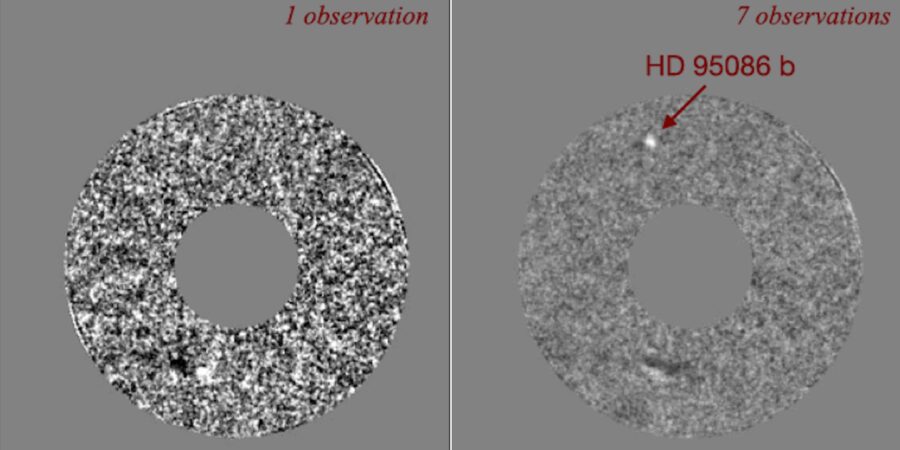
K-Stacker is a brute-force algorithm that consists in combining high contrast images acquired at different epochs by considering the orbital motion of potential planets present in the images to boost the ultimate detection limit (Le Coroller et al. 2020, A&A, 639; Nowak et al. 2018, 615; Le Coroller et al. 2015, Twenty years of giant exoplanets held at OHP). It is able to detect planets otherwise unreachable (i.e. even if an individual observation / image does not reveal the planet).
This algorithm also allows to revise direct-imaging observing strategy: instead of concentrating all the observations around a single epoch (for a simple stacking of the images without considering the Kepler motion of the planets), the observations can be split around several epochs, covering as much of the orbital period as possible. This K-Stacker strategy will allow to better constrain the orbital parameters and to schedule observations only under excellent weather conditions to reach the ultimate instrumental contrast (Le Coroller et al. 2022, A&A, Submitted). K-Stacker will help to search for Jupiter at 3-10 au around the nearest young stars, with first generation of E-ELT instruments like MICADO and HARMONI. It could aid in the search for Earth-like planets in the habitable zone of the nearest stars with future instruments of the E-ELT such as METIS.
Recently, the K-stacker algorithm has been put on github: https://github.com/kstacker
Figure caption: At left, HD 95086 b is at the limit of detectability in only one SPHERE-IFS observation of the H part of the spectrum (the point at the south-west of HD 95086 images is an artifact i.e. AO waffles not removed). At right, recombined image resulting from the SHINE K-Stacker run on HD 95086. K-Stacker looked blindly for the planet (without any information on the orbital parameters). The planets b is detected with an optimal signal to noise gain in root square of the total exposure time, passing from a S/N at one epoch of 3 to (S/N)ks = 10 (Le Coroller et al. 2020, A&A, 639).
-
K-Stacker permettra également de réviser la stratégie d'observation en imagerie directe
Au lieu de concentrer toutes les observations autour d’une seule époque (pour un simple empilement des images sans tenir compte du mouvement de Kepler des planètes), les observations peuvent être étalées sur plusieurs époques, couvrant une partie significative de la période orbitale des planètes recherchées. Cette stratégie permettra de mieux contraindre les paramètres orbitaux et de programmer les observations uniquement dans d’excellentes conditions météorologiques afin d’obtenir le meilleur contraste instrumental (Le Coroller et al. 2022, A&A, Soumis). K-Stacker permettra de rechercher des Jupiters jeunes à 3-10 a.u, avec les instruments de première génération de l’E-ELT comme MICADO, et HARMONI. K-Stacker pourrait aussi aider à la recherche de planètes semblables à la Terre dans la zone habitable des étoiles les plus proches avec les futurs instruments de l’E-ELT tels que METIS.
L’algorithme K-Stacker est en open source sur github: https://github.com/kstacker
-
Légende de la Figure
A gauche, HD 95086 b est à la limite de la détectabilité dans une seule observation SPHERE-IFS de la bande H du spectre (le point au sud-ouest est un artefact, lié aux « waffles » de l’optique Adaptative). A droite, image recombinée par K-Stacker à partir de 7 observations de HD 95086 dans le cadre du relevé SHINE. K-Stacker a recherché la planète en aveugle (sans aucune information sur les paramètres orbitaux). La planète b est détectée avec un gain signal/bruit optimal en racine carrée du temps d’exposition total, passant d’un S/N = 3 à une époque à (S/N)ks = 10 (Le Coroller et al. 2020, A&A, 639).




